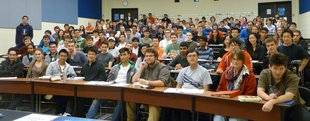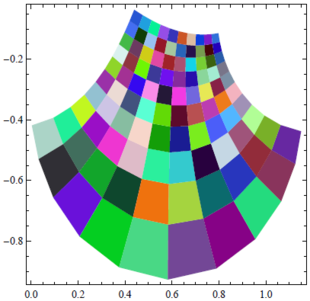12-240/Classnotes for Tuesday October 09: Difference between revisions
| Line 29: | Line 29: | ||
(=>) every element of V can be written as a linear combination of elements of β in a unique way. |
(=>) every element of V can be written as a linear combination of elements of β in a unique way. |
||
So, suppose <math>\sum \!\,</math> |
So, suppose <math>\sum \!\,</math> ai∙ui = v = <math>\sum \!\,</math> bi∙ui |
||
Thus <math>\sum \!\,</math> |
Thus <math>\sum \!\,</math> ai∙ui - <math>\sum \!\,</math> bi∙ui = 0 |
||
<math>\sum \!\,</math> (ai-bi) |
<math>\sum \!\,</math> (ai-bi)∙ui = 0 |
||
β is linear independent hence (ai - bi)= 0 <math>\forall\!\,</math> i |
β is linear independent hence (ai - bi)= 0 <math>\forall\!\,</math> i |
||
Revision as of 04:49, 7 December 2012
| |||||||||||||||||||||||||||||||||||||||||||||||||||||||||
In this lecture, the professor concentrate on basics and related theorems.
Definition of basic
β V is a basic if
1/ It generates ( span) V, span β = V
2/ It is linearly independent
theorems
1/ β is a basic of V iff every element of V can be written as a linear combination of elements of β in a unique way.
proof: ( in the case β is finite)
β = {u1, u2, ..., un}
(<=) need to show that β = span(V) and β is linearly independent.
The fact that β span is the fact that every element of V can be written as a linear combination of elements of β, which is given
Assume ai.ui = 0 ai F, ui β
ai.ui = 0 = 0.ui
since 0 can be written as a linear combination of elements of β in a unique way, ai=0 i
Hence β is linearly independent
(=>) every element of V can be written as a linear combination of elements of β in a unique way.
So, suppose ai∙ui = v = bi∙ui
Thus ai∙ui - bi∙ui = 0
(ai-bi)∙ui = 0
β is linear independent hence (ai - bi)= 0 i
i.e ai = bi, hence the combination is unique.
Clarification on lecture notes
On page 3, we find that then we say . The reason is, the Theorem 1.5 in the textbook.
Theorem 1.5: The span of any subset of a vector space is a subspace of . Moreover, any subspace of that contains must also contain
Since is a subset of , is a subspace of from the first part of the Theorem 1.5. We have shown (in the lecture notes page 3) that . From the "Moreover" part of Theorem 1.5, since is a subspace of containing , must also contain .























